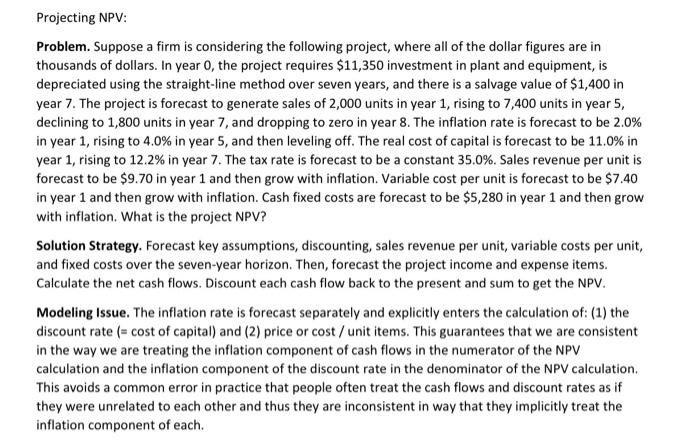Answered step by step
Verified Expert Solution
Question
1 Approved Answer
This is for the course Capital Budgeting and Financial Modeling Use Excel to answe as instructed below. All excel model should be created in a
This is for the course Capital Budgeting and Financial Modeling 
Projecting NPV: Problem. Suppose a firm is considering the following project, where all of the dollar figures are in thousands of dollars. In year 0, the project requires $11,350 investment in plant and equipment, is depreciated using the straight-line method over seven years, and there is a salvage value of $1,400 in year 7. The project is forecast to generate sales of 2,000 units in year 1, rising to 7,400 units in year 5, declining to 1,800 units in year 7, and dropping to zero in year 8. The inflation rate is forecast to be 2.0% in year 1, rising to 4.0% in year 5, and then leveling off. The real cost of capital is forecast to be 11.0% in year 1, rising to 12.2% in year 7. The tax rate is forecast to be a constant 35.0%. Sales revenue per unit is forecast to be $9.70 in year 1 and then grow with inflation. Variable cost per unit is forecast to be $7.40 in year 1 and then grow with inflation. Cash fixed costs are forecast to be $5,280 in year 1 and then grow with inflation. What is the project NPV? Solution Strategy. Forecast key assumptions, discounting, sales revenue per unit, variable costs per unit, and fixed costs over the seven-year horizon. Then, forecast the project income and expense items. Calculate the net cash flows. Discount each cash flow back to the present and sum to get the NPV. Modeling Issue. The inflation rate is forecast separately and explicitly enters the calculation of: (1) the discount rate (= cost of capital) and (2) price or cost / unit items. This guarantees that we are consistent in the way we are treating the inflation component of cash flows in the numerator of the NPV calculation and the inflation component of the discount rate in the denominator of the NPV calculation. This avoids a common error in practice that people often treat the cash flows and discount rates as if they were unrelated to each other and thus they are inconsistent in way that they implicitly treat the inflation component of each. Projecting NPV: Problem. Suppose a firm is considering the following project, where all of the dollar figures are in thousands of dollars. In year 0, the project requires $11,350 investment in plant and equipment, is depreciated using the straight-line method over seven years, and there is a salvage value of $1,400 in year 7. The project is forecast to generate sales of 2,000 units in year 1, rising to 7,400 units in year 5, declining to 1,800 units in year 7, and dropping to zero in year 8. The inflation rate is forecast to be 2.0% in year 1, rising to 4.0% in year 5, and then leveling off. The real cost of capital is forecast to be 11.0% in year 1, rising to 12.2% in year 7. The tax rate is forecast to be a constant 35.0%. Sales revenue per unit is forecast to be $9.70 in year 1 and then grow with inflation. Variable cost per unit is forecast to be $7.40 in year 1 and then grow with inflation. Cash fixed costs are forecast to be $5,280 in year 1 and then grow with inflation. What is the project NPV? Solution Strategy. Forecast key assumptions, discounting, sales revenue per unit, variable costs per unit, and fixed costs over the seven-year horizon. Then, forecast the project income and expense items. Calculate the net cash flows. Discount each cash flow back to the present and sum to get the NPV. Modeling Issue. The inflation rate is forecast separately and explicitly enters the calculation of: (1) the discount rate (= cost of capital) and (2) price or cost / unit items. This guarantees that we are consistent in the way we are treating the inflation component of cash flows in the numerator of the NPV calculation and the inflation component of the discount rate in the denominator of the NPV calculation. This avoids a common error in practice that people often treat the cash flows and discount rates as if they were unrelated to each other and thus they are inconsistent in way that they implicitly treat the inflation component of each Use Excel to answe as instructed below.
All excel model should be created in a consistent format and follow the suggested best practice listed below:
Structure your model as clearly and simply as possible
Usable in your absence
Assumptions should be clustered together
Save often (Ctrl s) and keep saving new versions of your model; Excel does crash sometimes
Take time to take a step back and think

Step by Step Solution
There are 3 Steps involved in it
Step: 1

Get Instant Access to Expert-Tailored Solutions
See step-by-step solutions with expert insights and AI powered tools for academic success
Step: 2

Step: 3

Ace Your Homework with AI
Get the answers you need in no time with our AI-driven, step-by-step assistance
Get Started


